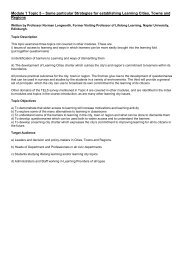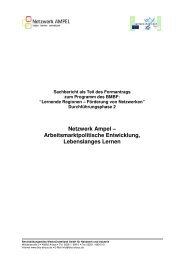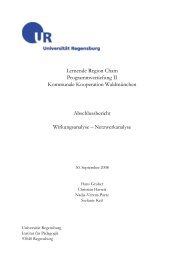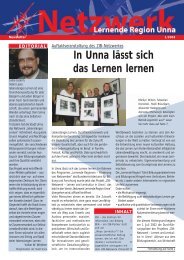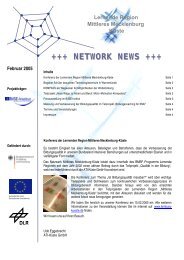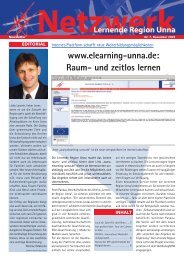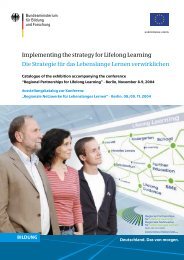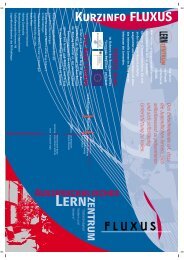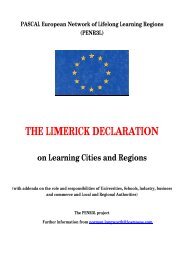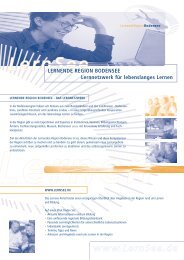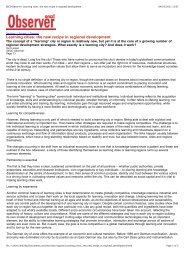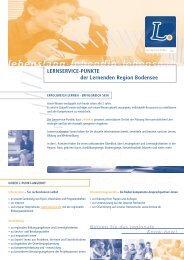SWOT-analysis as a basis for regional strategies - EUROlocal
SWOT-analysis as a basis for regional strategies - EUROlocal
SWOT-analysis as a basis for regional strategies - EUROlocal
Create successful ePaper yourself
Turn your PDF publications into a flip-book with our unique Google optimized e-Paper software.
Table 9. Partnership and social learning<br />
• In light of the objective and function of the Swedish Growth Agreements, it is hardly surprising<br />
that relatively high priority is given to creating better functioning links between the business and<br />
educational spheres. Yet, perhaps surprisingly, little attention is given to the elements of<br />
partnership within the <strong>SWOT</strong>. In view of the strategic goals of the programmes this is an area<br />
which can be further developed and also translated into concrete me<strong>as</strong>ures. Thus by paying heed<br />
to the need to incorporate better the nature of <strong>regional</strong> development programmes <strong>as</strong> a process, the<br />
ability to tap <strong>regional</strong> resources closely connected to social capital can be translated into activities<br />
supporting <strong>regional</strong> competitiveness.<br />
• In the Finnish Regional Development Programmes the integration of internal <strong>analysis</strong>, paying<br />
attention to the implementing organisations, <strong>as</strong> well <strong>as</strong> various groups and organisations<br />
representing society more generally can also be developed further. Although in some are<strong>as</strong>, where<br />
various partnership organisations necessarily have a central role, attention is paid to this<br />
organisational potential, these resources are less clearly present in the over-all strategy. If<br />
partnership is to be a contributing factor in <strong>regional</strong> strategy <strong>for</strong>mation <strong>as</strong> well <strong>as</strong> implementation,<br />
it needs to be incorporated into the planning process from an early stage. (The same applies <strong>for</strong><br />
other programmes.)<br />
• There does not seem to be great difference between the Objective 1 and Objective 2<br />
Programmes in terms of the attention given to the internal <strong>analysis</strong> of the implementation<br />
structure and partnership. The need to strengthen co-operation between economic life and the<br />
R&D sector is referred to in most programmes. Some also make at le<strong>as</strong>t some reference to the<br />
opportunities provided by the new organisational and working methods and voluntary<br />
organisations. The Danish Objective 2 Programme seems to give more attention to internal<br />
organisational factors concerning implementation structure, including <strong>for</strong> instance improved<br />
administrative co-ordination and developing the organisation and functioning of the public sector.<br />
• Co-operation traditions are especially central to the whole ethos of the Interreg Programmes,<br />
which also represent a unique c<strong>as</strong>e due to their cross-border and international nature. In some<br />
c<strong>as</strong>es the cross-border resources could be even further emph<strong>as</strong>ised. This applies in particular to<br />
programmes which are highly dependent on governmental policy decisions in order to pursue their<br />
own policy goals. (The predominance of the ferry traffic question in Kvarken-Mittskandia<br />
Programme could be cited <strong>as</strong> an example here.)<br />
On the b<strong>as</strong>is of the <strong>analysis</strong> undertaken here, some tentative conclusions on<br />
organisational learning and partnership can be drawn.<br />
• Elements of learning discernible in the programming documents are reflected in learning in the<br />
organisational level (implementation structure) and in the programme content level, <strong>as</strong><br />
elements improving the <strong>regional</strong> development instruments. To be able to <strong>as</strong>sess learning, we<br />
need to compare programmes from different programming periods and not only look at the<br />
<strong>SWOT</strong> tables themselves, but also <strong>regional</strong> analyses and <strong>strategies</strong> on a more general level.<br />
• European Union programming instruments are well taken into account in mainstream<br />
Objective programmes and Interreg programmes, <strong>as</strong> they are usually b<strong>as</strong>ed on the same<br />
geographical area <strong>as</strong> in the previous programme period. There are certain differences,<br />
however. Objective 1 are<strong>as</strong> of Sweden and Finland now also cover some are<strong>as</strong> that were under<br />
Objectives 2 and 5b in the <strong>for</strong>mer period. Interestingly enough this h<strong>as</strong> not been reflected in<br />
the <strong>SWOT</strong> <strong>analysis</strong>, though it h<strong>as</strong> had an influence on <strong>strategies</strong> and me<strong>as</strong>ures. In general,<br />
improvements have been made both in the content of <strong>SWOT</strong> and its consistency with the<br />
<strong>analysis</strong> of a region, on the one hand, and the <strong>strategies</strong>, on the other. EU programmes also<br />
quite often have references to other programmes, not only to the earlier programme document.<br />
Transnational EU programmes relevant to programme are<strong>as</strong> are often referred to in this<br />
context.<br />
51



